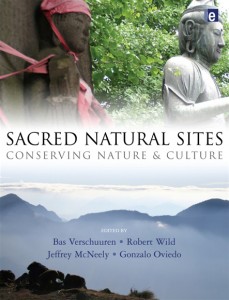
Un novo libro, Sacred Sitios Natural: Conservación da natureza e da cultura, está a ser lanzado pola IUCN hoxe na Convención sobre Diversidade Biolóxica, en conferencia de Nagoya, Xapón. O lanzamento forma parte dun evento organizado a través dunha colaboración entre ETC-COMPAS e UICN e está dedicado a promover os lugares naturais sagrados e o seu papel crucial na conservación da natureza e a cultura. O libro está baseado en experiencias de todo o mundo que pon de manifesto a importancia dos sitios naturais sagrados na conservación da biodiversidade e as relacións de longa data entre a natureza e as persoas.
Sagrados sitios naturais son aquelas recoñecidas como sagrado polos pobos indíxenas e tradicionais e zonas recoñecidas polas relixións ou crenzas como lugares para a adoración e recordo. They are the world’s oldest conservation areas and contain high levels of biological and cultural diversity. Eles protexen unha gran variedade de hábitats, costumes tradicionais garda, practices and knowledge related to biodiversity conservation and promote mutual respect between people and nature.
But today this global natural and social conservation network is not sufficiently understood or recognized. É sub-financiado e cada vez máis baixo ameaza. Coma nós continuamente promover o desenvolvemento a costa do mundo natural, we are destroying these sites through ignorance, overconsumption and overexploitation of resources. We are also largely unaware of their significance in maintaining and restoring meaningful and sustainable relationships between humans and nature.
“Sacred natural sites provide for the protection of biodiversity but also for the continuation of cultural practices,” says Baixo Verschuuren, Co-chair of IUCN’s Specialist Group on Cultural and Spiritual Values of Protected Areas and programme coordinator with ETC-COMPASand lead editor of the book. “As most of the threats that sacred natural sites face today, such as tourism, industrialization and urbanization, affect both cultural and biological values, they weaken the special relationship between people and nature that is so typical to these areas and so precious not only to many cultures around the world but also to humanity as a whole.”
Other editors of the book include Robert G. Salvaxe, Chair of the IUCN’s Specialist Group on Cultural and Spiritual Values of Protected Areas, Jeffrey A. McNeely, IUCN’s Senior Science Advisor eGonzalo Oviedo IUCN Senior Advisor for Social Policy. The book contains 27 chapters contributed by 55 authors which focus on a wide geographical spread of both iconic and lesser known examples of sacred natural sites. These sites exist in and outside protected areas or other designated areas and include the sacred groves of the Western Ghats (India), the sacred mountains of Sagarmatha /Chomolongma (Mt Everest, Nepal, Tíbet – e en China), as montañas de Ouro de Altai (Rusia) and the Holy Island of Lindisfarne (Reino Unido) e os lagos sagrados do Delta do Níxer (Nixeria).
“Networks of sacred natural sites are found in every country,” says Jeff McNeely. “Many of them are hotspots of biocultural diversity. Although The Convention on Biological Diversity recognizes their importance, the need for greater recognition, conservation and restoration should be made more explicit.”
The authors also highlight the need to recognize the crucial role that custodians of these areas play in the protection of their natural and cultural diversity.
“Custodians of sacred natural sites bear unique responsibilities within local, indigenous and religious communities.” says Gonzalo Oviedo. “They play a vital role in the governance of their community and their relationship with the earth. They have some unique knowledge of cultural and spiritual practices, traditional medicine, livestock breeding and agricultural cycles. They contribute to universal values that maintain people’s relationships with the earth.”
IUCN, through its Specialist Group on Cultural and Spiritual Values of Protected Areas, is actively engaged in helping to protect these sites. But much more still needs to be done.
“We would like to see better management of these areas that recognize and respect the sound conservation knowledge of custodians and communities,. This requires support from policy makers, conservation experts, lawyers and academics,” says Robert Salvaxe. “Improved understanding and greater public awareness of the biological and cultural values of these sites are also necessary if we want to preserve these precious examples of our planet’s bio-cultural diversity. Further sacred natural sites provide models of the deepest ethical relationships of humanity with nature, critical signposts for all of us given the serious global challenges humanity is facing.”
The Convention on Biological Diversity started to recognize the importance of sacred sites when it issued the Akwé: Kon Voluntary Guidelines for Impact Assessment in Sacred Sites en 2004. The Conference of the Parties is currently discussing the CBD Programme of Work on Protected Areas, which – although not explicitly addressing sacred natural sites – offers opportunities for action to protect them. The Conference is also considering a proposed programme of work on cultural diversity jointly with UNESCO, where sacred sites may become an important topic. IUCN is calling the CBD parties to give more attention to sacred sites through these and other programmes and measures.
 Para máis información, póñase en contacto:
Para máis información, póñase en contacto:
Gonzalo Oviedo
IUCN’s Senior Adviser, Social Policy
correo electrónico: gonzalo.oviedo@iucn.org
tel. +81 (0) 80 10 03 40 67
Baixo Verschuuren
Co-chair of IUCN’s Specialist Group on
Cultural and Spiritual Values of Protected Areas
correo electrónico: basverschuuren@gmail.com
Orixe: iucn.org






